Research on Air Pollution and Human Health - PSCC Assignment
VerifiedAdded on 2022/08/21
|5
|1369
|25
Essay
AI Summary
This essay discusses the serious health impacts of air pollution, noting that a significant portion of global deaths from lung cancer, stroke, and heart disease are attributable to it. It highlights how micro pollutants bypass the body's defenses, damaging the respiratory and circulatory systems, and affecting organs like the brain, lungs, and heart. The essay also connects air pollution to climate change, emphasizing the role of fossil fuel combustion. It identifies key pollutants such as ground-level ozone and particulate matter, detailing their sources and adverse health effects, including respiratory diseases, cardiovascular issues, and cognitive impairment, especially in children. The essay concludes by referencing strategies from the World Health Organization and the Climate and Clean Air Coalition aimed at improving air quality and mitigating the negative health impacts through actions focused on waste management, transport improvement, and sustainable energy solutions.
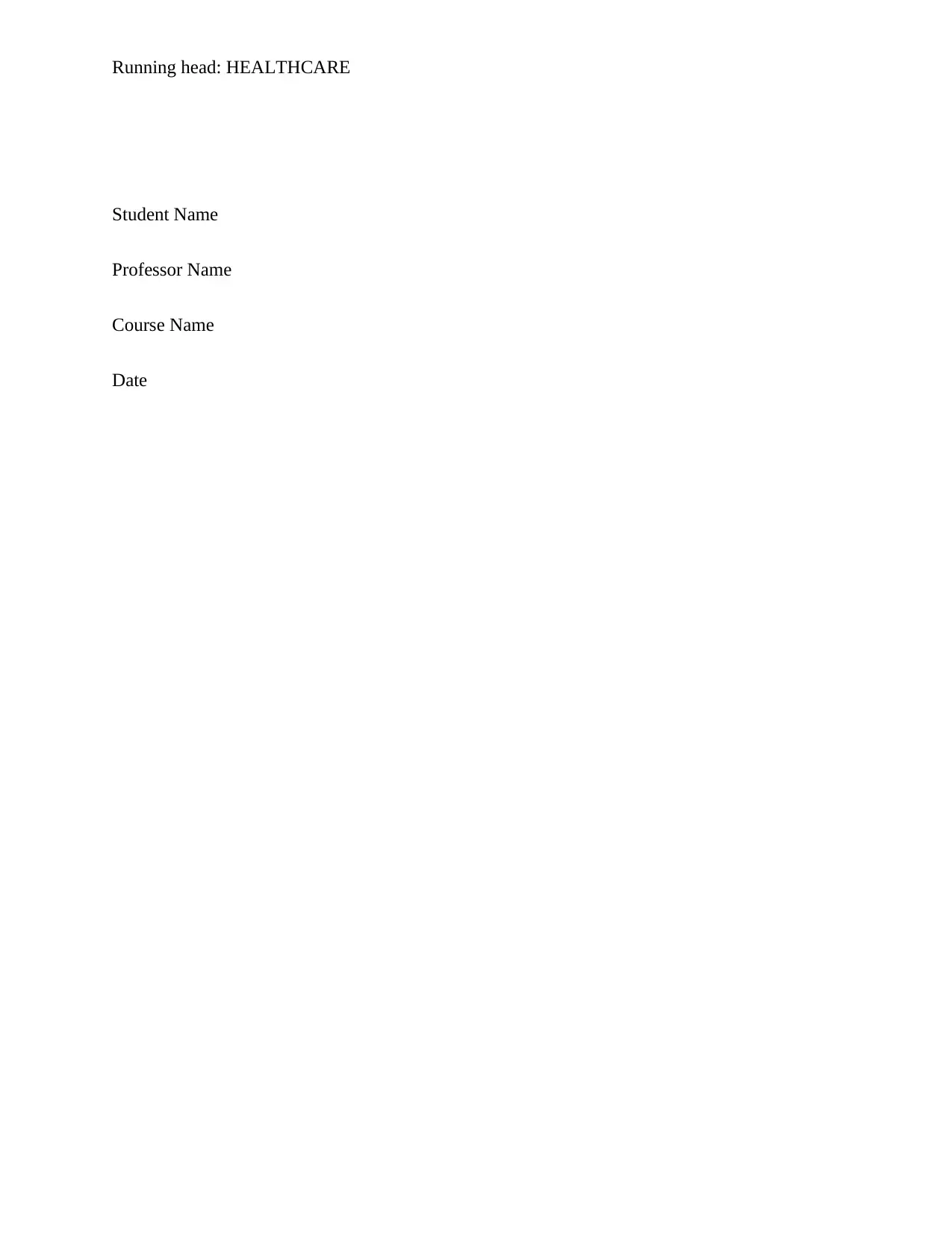
Running head: HEALTHCARE
Student Name
Professor Name
Course Name
Date
Student Name
Professor Name
Course Name
Date
Paraphrase This Document
Need a fresh take? Get an instant paraphrase of this document with our AI Paraphraser
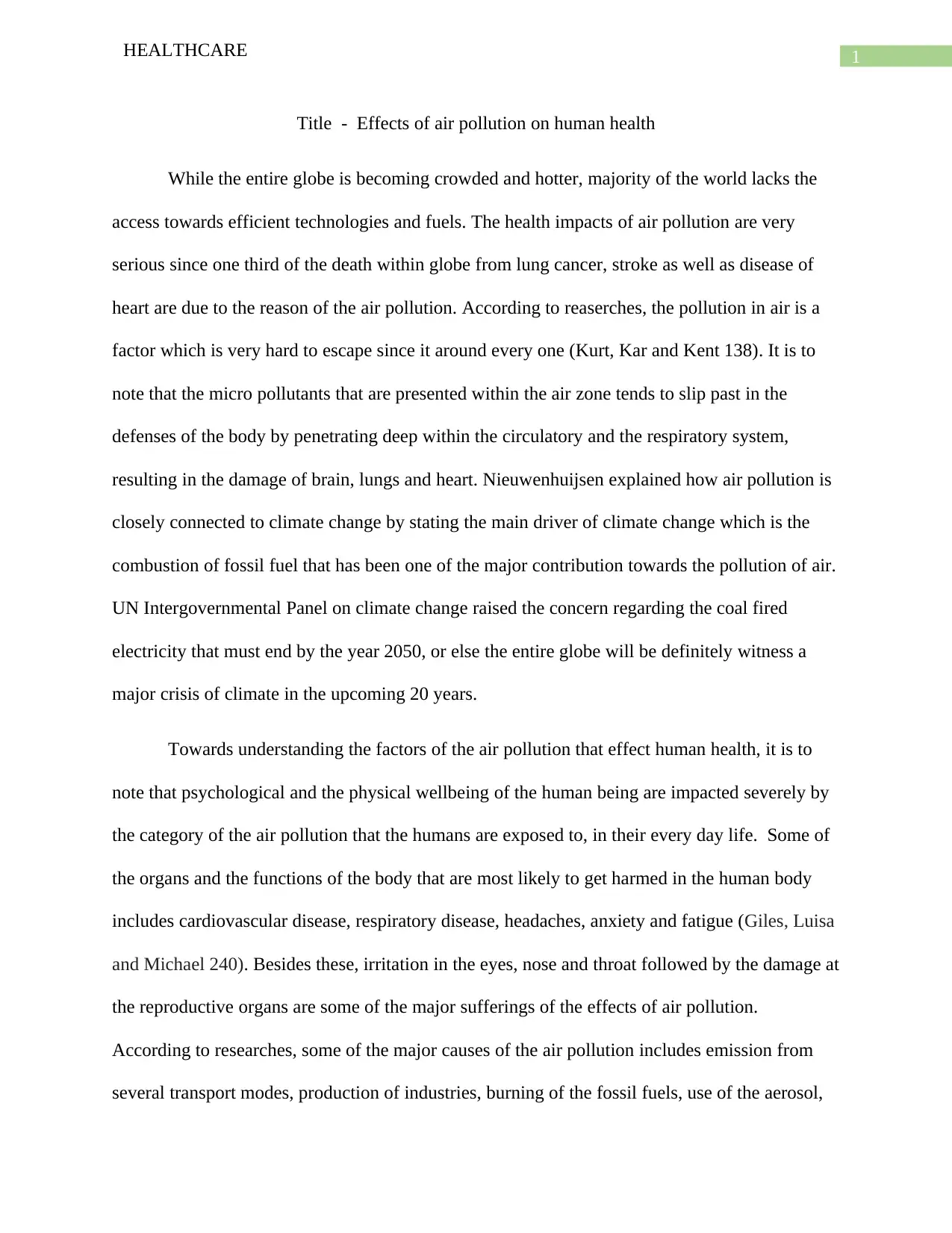
1HEALTHCARE
Title - Effects of air pollution on human health
While the entire globe is becoming crowded and hotter, majority of the world lacks the
access towards efficient technologies and fuels. The health impacts of air pollution are very
serious since one third of the death within globe from lung cancer, stroke as well as disease of
heart are due to the reason of the air pollution. According to reaserches, the pollution in air is a
factor which is very hard to escape since it around every one (Kurt, Kar and Kent 138). It is to
note that the micro pollutants that are presented within the air zone tends to slip past in the
defenses of the body by penetrating deep within the circulatory and the respiratory system,
resulting in the damage of brain, lungs and heart. Nieuwenhuijsen explained how air pollution is
closely connected to climate change by stating the main driver of climate change which is the
combustion of fossil fuel that has been one of the major contribution towards the pollution of air.
UN Intergovernmental Panel on climate change raised the concern regarding the coal fired
electricity that must end by the year 2050, or else the entire globe will be definitely witness a
major crisis of climate in the upcoming 20 years.
Towards understanding the factors of the air pollution that effect human health, it is to
note that psychological and the physical wellbeing of the human being are impacted severely by
the category of the air pollution that the humans are exposed to, in their every day life. Some of
the organs and the functions of the body that are most likely to get harmed in the human body
includes cardiovascular disease, respiratory disease, headaches, anxiety and fatigue (Giles, Luisa
and Michael 240). Besides these, irritation in the eyes, nose and throat followed by the damage at
the reproductive organs are some of the major sufferings of the effects of air pollution.
According to researches, some of the major causes of the air pollution includes emission from
several transport modes, production of industries, burning of the fossil fuels, use of the aerosol,
Title - Effects of air pollution on human health
While the entire globe is becoming crowded and hotter, majority of the world lacks the
access towards efficient technologies and fuels. The health impacts of air pollution are very
serious since one third of the death within globe from lung cancer, stroke as well as disease of
heart are due to the reason of the air pollution. According to reaserches, the pollution in air is a
factor which is very hard to escape since it around every one (Kurt, Kar and Kent 138). It is to
note that the micro pollutants that are presented within the air zone tends to slip past in the
defenses of the body by penetrating deep within the circulatory and the respiratory system,
resulting in the damage of brain, lungs and heart. Nieuwenhuijsen explained how air pollution is
closely connected to climate change by stating the main driver of climate change which is the
combustion of fossil fuel that has been one of the major contribution towards the pollution of air.
UN Intergovernmental Panel on climate change raised the concern regarding the coal fired
electricity that must end by the year 2050, or else the entire globe will be definitely witness a
major crisis of climate in the upcoming 20 years.
Towards understanding the factors of the air pollution that effect human health, it is to
note that psychological and the physical wellbeing of the human being are impacted severely by
the category of the air pollution that the humans are exposed to, in their every day life. Some of
the organs and the functions of the body that are most likely to get harmed in the human body
includes cardiovascular disease, respiratory disease, headaches, anxiety and fatigue (Giles, Luisa
and Michael 240). Besides these, irritation in the eyes, nose and throat followed by the damage at
the reproductive organs are some of the major sufferings of the effects of air pollution.
According to researches, some of the major causes of the air pollution includes emission from
several transport modes, production of industries, burning of the fossil fuels, use of the aerosol,
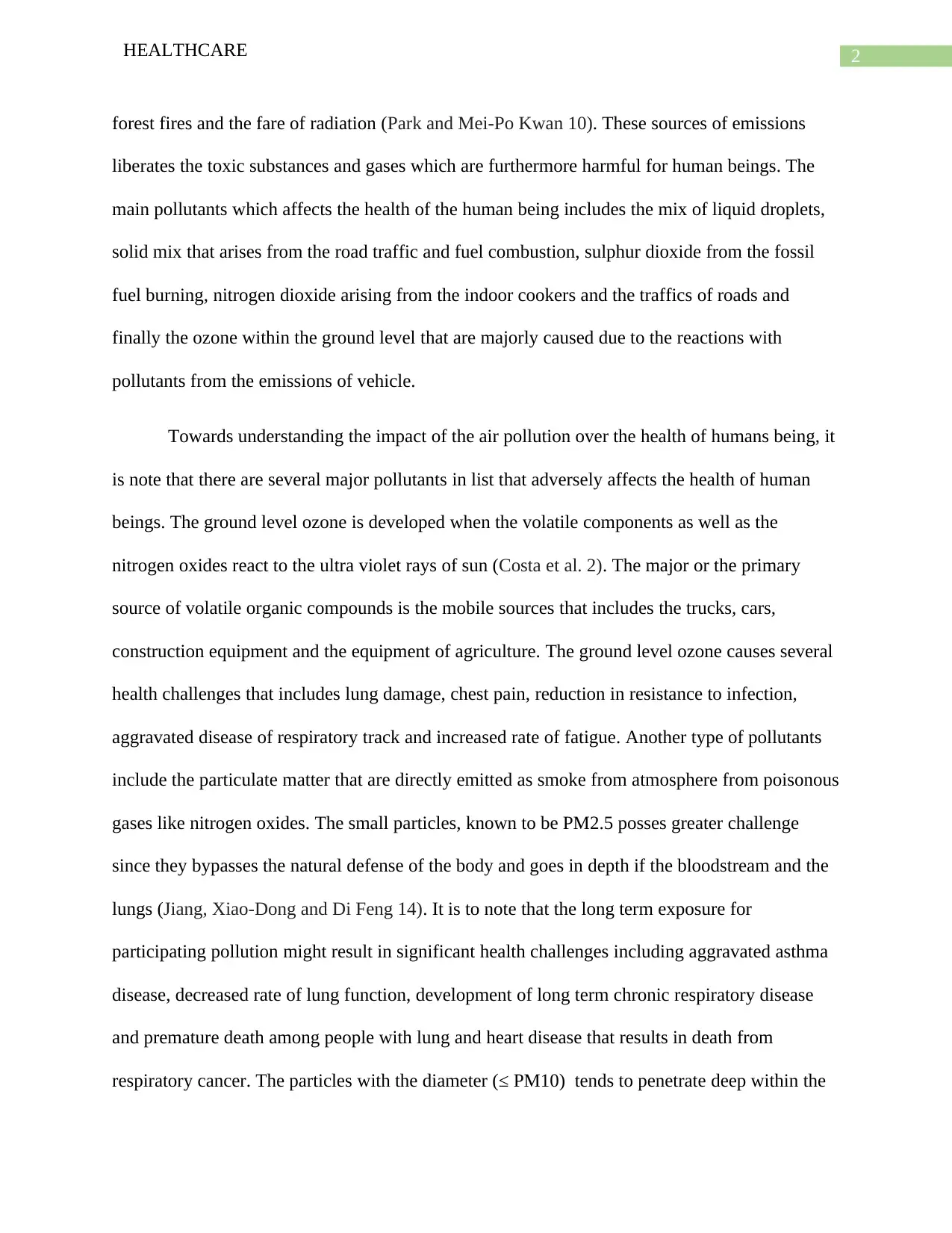
2HEALTHCARE
forest fires and the fare of radiation (Park and Mei-Po Kwan 10). These sources of emissions
liberates the toxic substances and gases which are furthermore harmful for human beings. The
main pollutants which affects the health of the human being includes the mix of liquid droplets,
solid mix that arises from the road traffic and fuel combustion, sulphur dioxide from the fossil
fuel burning, nitrogen dioxide arising from the indoor cookers and the traffics of roads and
finally the ozone within the ground level that are majorly caused due to the reactions with
pollutants from the emissions of vehicle.
Towards understanding the impact of the air pollution over the health of humans being, it
is note that there are several major pollutants in list that adversely affects the health of human
beings. The ground level ozone is developed when the volatile components as well as the
nitrogen oxides react to the ultra violet rays of sun (Costa et al. 2). The major or the primary
source of volatile organic compounds is the mobile sources that includes the trucks, cars,
construction equipment and the equipment of agriculture. The ground level ozone causes several
health challenges that includes lung damage, chest pain, reduction in resistance to infection,
aggravated disease of respiratory track and increased rate of fatigue. Another type of pollutants
include the particulate matter that are directly emitted as smoke from atmosphere from poisonous
gases like nitrogen oxides. The small particles, known to be PM2.5 posses greater challenge
since they bypasses the natural defense of the body and goes in depth if the bloodstream and the
lungs (Jiang, Xiao-Dong and Di Feng 14). It is to note that the long term exposure for
participating pollution might result in significant health challenges including aggravated asthma
disease, decreased rate of lung function, development of long term chronic respiratory disease
and premature death among people with lung and heart disease that results in death from
respiratory cancer. The particles with the diameter (≤ PM10) tends to penetrate deep within the
forest fires and the fare of radiation (Park and Mei-Po Kwan 10). These sources of emissions
liberates the toxic substances and gases which are furthermore harmful for human beings. The
main pollutants which affects the health of the human being includes the mix of liquid droplets,
solid mix that arises from the road traffic and fuel combustion, sulphur dioxide from the fossil
fuel burning, nitrogen dioxide arising from the indoor cookers and the traffics of roads and
finally the ozone within the ground level that are majorly caused due to the reactions with
pollutants from the emissions of vehicle.
Towards understanding the impact of the air pollution over the health of humans being, it
is note that there are several major pollutants in list that adversely affects the health of human
beings. The ground level ozone is developed when the volatile components as well as the
nitrogen oxides react to the ultra violet rays of sun (Costa et al. 2). The major or the primary
source of volatile organic compounds is the mobile sources that includes the trucks, cars,
construction equipment and the equipment of agriculture. The ground level ozone causes several
health challenges that includes lung damage, chest pain, reduction in resistance to infection,
aggravated disease of respiratory track and increased rate of fatigue. Another type of pollutants
include the particulate matter that are directly emitted as smoke from atmosphere from poisonous
gases like nitrogen oxides. The small particles, known to be PM2.5 posses greater challenge
since they bypasses the natural defense of the body and goes in depth if the bloodstream and the
lungs (Jiang, Xiao-Dong and Di Feng 14). It is to note that the long term exposure for
participating pollution might result in significant health challenges including aggravated asthma
disease, decreased rate of lung function, development of long term chronic respiratory disease
and premature death among people with lung and heart disease that results in death from
respiratory cancer. The particles with the diameter (≤ PM10) tends to penetrate deep within the
⊘ This is a preview!⊘
Do you want full access?
Subscribe today to unlock all pages.

Trusted by 1+ million students worldwide
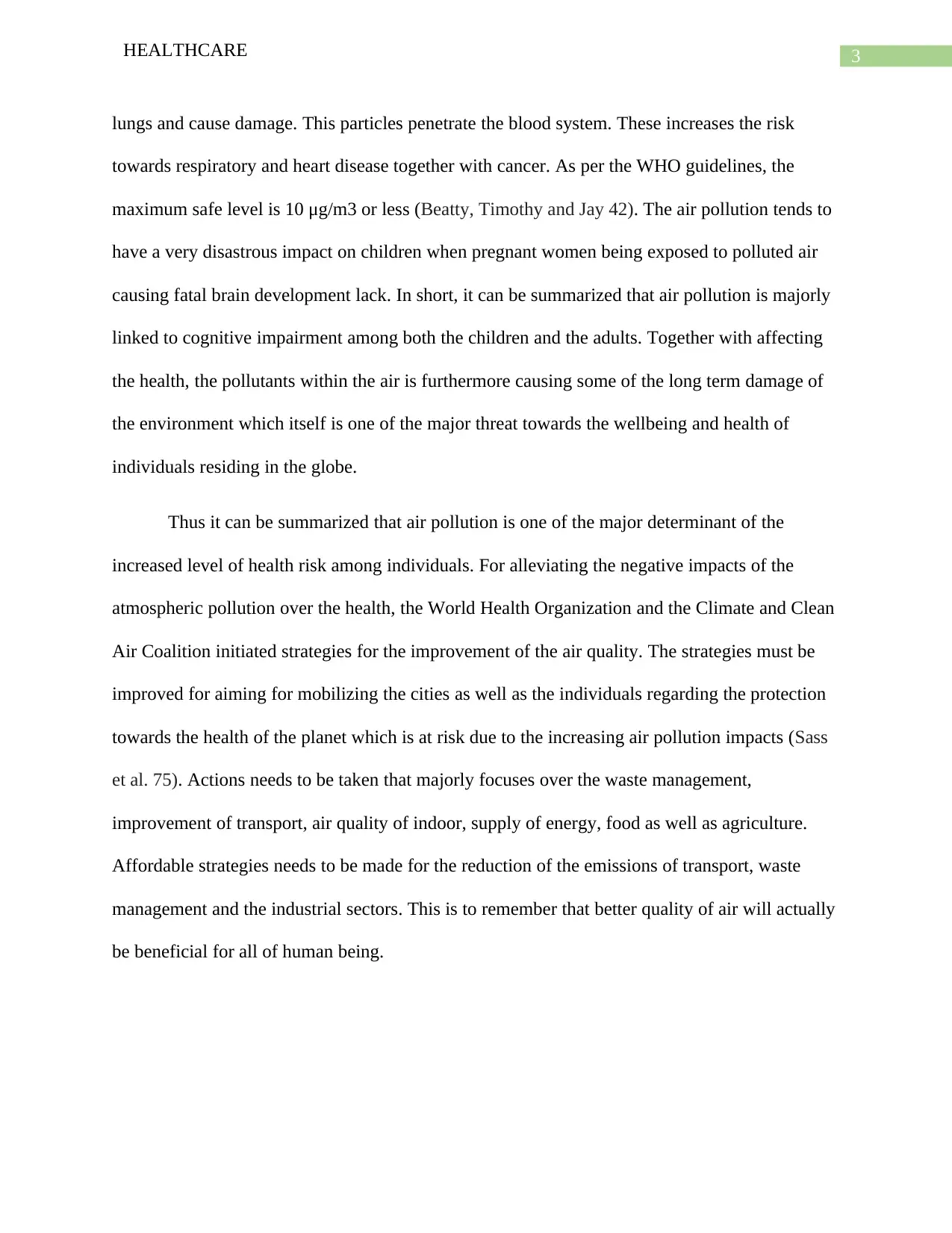
3HEALTHCARE
lungs and cause damage. This particles penetrate the blood system. These increases the risk
towards respiratory and heart disease together with cancer. As per the WHO guidelines, the
maximum safe level is 10 μg/m3 or less (Beatty, Timothy and Jay 42). The air pollution tends to
have a very disastrous impact on children when pregnant women being exposed to polluted air
causing fatal brain development lack. In short, it can be summarized that air pollution is majorly
linked to cognitive impairment among both the children and the adults. Together with affecting
the health, the pollutants within the air is furthermore causing some of the long term damage of
the environment which itself is one of the major threat towards the wellbeing and health of
individuals residing in the globe.
Thus it can be summarized that air pollution is one of the major determinant of the
increased level of health risk among individuals. For alleviating the negative impacts of the
atmospheric pollution over the health, the World Health Organization and the Climate and Clean
Air Coalition initiated strategies for the improvement of the air quality. The strategies must be
improved for aiming for mobilizing the cities as well as the individuals regarding the protection
towards the health of the planet which is at risk due to the increasing air pollution impacts (Sass
et al. 75). Actions needs to be taken that majorly focuses over the waste management,
improvement of transport, air quality of indoor, supply of energy, food as well as agriculture.
Affordable strategies needs to be made for the reduction of the emissions of transport, waste
management and the industrial sectors. This is to remember that better quality of air will actually
be beneficial for all of human being.
lungs and cause damage. This particles penetrate the blood system. These increases the risk
towards respiratory and heart disease together with cancer. As per the WHO guidelines, the
maximum safe level is 10 μg/m3 or less (Beatty, Timothy and Jay 42). The air pollution tends to
have a very disastrous impact on children when pregnant women being exposed to polluted air
causing fatal brain development lack. In short, it can be summarized that air pollution is majorly
linked to cognitive impairment among both the children and the adults. Together with affecting
the health, the pollutants within the air is furthermore causing some of the long term damage of
the environment which itself is one of the major threat towards the wellbeing and health of
individuals residing in the globe.
Thus it can be summarized that air pollution is one of the major determinant of the
increased level of health risk among individuals. For alleviating the negative impacts of the
atmospheric pollution over the health, the World Health Organization and the Climate and Clean
Air Coalition initiated strategies for the improvement of the air quality. The strategies must be
improved for aiming for mobilizing the cities as well as the individuals regarding the protection
towards the health of the planet which is at risk due to the increasing air pollution impacts (Sass
et al. 75). Actions needs to be taken that majorly focuses over the waste management,
improvement of transport, air quality of indoor, supply of energy, food as well as agriculture.
Affordable strategies needs to be made for the reduction of the emissions of transport, waste
management and the industrial sectors. This is to remember that better quality of air will actually
be beneficial for all of human being.
Paraphrase This Document
Need a fresh take? Get an instant paraphrase of this document with our AI Paraphraser
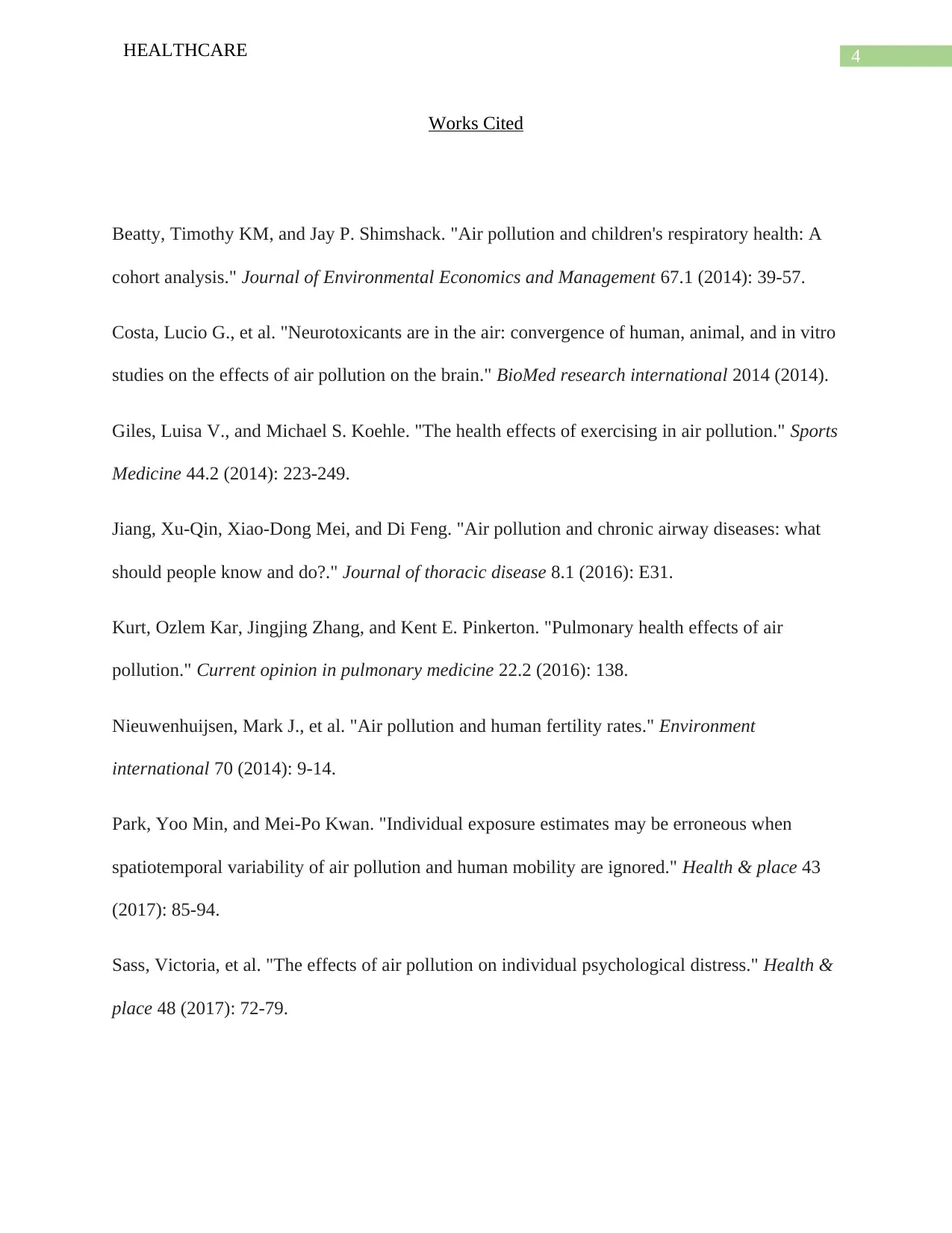
4HEALTHCARE
Works Cited
Beatty, Timothy KM, and Jay P. Shimshack. "Air pollution and children's respiratory health: A
cohort analysis." Journal of Environmental Economics and Management 67.1 (2014): 39-57.
Costa, Lucio G., et al. "Neurotoxicants are in the air: convergence of human, animal, and in vitro
studies on the effects of air pollution on the brain." BioMed research international 2014 (2014).
Giles, Luisa V., and Michael S. Koehle. "The health effects of exercising in air pollution." Sports
Medicine 44.2 (2014): 223-249.
Jiang, Xu-Qin, Xiao-Dong Mei, and Di Feng. "Air pollution and chronic airway diseases: what
should people know and do?." Journal of thoracic disease 8.1 (2016): E31.
Kurt, Ozlem Kar, Jingjing Zhang, and Kent E. Pinkerton. "Pulmonary health effects of air
pollution." Current opinion in pulmonary medicine 22.2 (2016): 138.
Nieuwenhuijsen, Mark J., et al. "Air pollution and human fertility rates." Environment
international 70 (2014): 9-14.
Park, Yoo Min, and Mei-Po Kwan. "Individual exposure estimates may be erroneous when
spatiotemporal variability of air pollution and human mobility are ignored." Health & place 43
(2017): 85-94.
Sass, Victoria, et al. "The effects of air pollution on individual psychological distress." Health &
place 48 (2017): 72-79.
Works Cited
Beatty, Timothy KM, and Jay P. Shimshack. "Air pollution and children's respiratory health: A
cohort analysis." Journal of Environmental Economics and Management 67.1 (2014): 39-57.
Costa, Lucio G., et al. "Neurotoxicants are in the air: convergence of human, animal, and in vitro
studies on the effects of air pollution on the brain." BioMed research international 2014 (2014).
Giles, Luisa V., and Michael S. Koehle. "The health effects of exercising in air pollution." Sports
Medicine 44.2 (2014): 223-249.
Jiang, Xu-Qin, Xiao-Dong Mei, and Di Feng. "Air pollution and chronic airway diseases: what
should people know and do?." Journal of thoracic disease 8.1 (2016): E31.
Kurt, Ozlem Kar, Jingjing Zhang, and Kent E. Pinkerton. "Pulmonary health effects of air
pollution." Current opinion in pulmonary medicine 22.2 (2016): 138.
Nieuwenhuijsen, Mark J., et al. "Air pollution and human fertility rates." Environment
international 70 (2014): 9-14.
Park, Yoo Min, and Mei-Po Kwan. "Individual exposure estimates may be erroneous when
spatiotemporal variability of air pollution and human mobility are ignored." Health & place 43
(2017): 85-94.
Sass, Victoria, et al. "The effects of air pollution on individual psychological distress." Health &
place 48 (2017): 72-79.
1 out of 5
Related Documents
Your All-in-One AI-Powered Toolkit for Academic Success.
+13062052269
info@desklib.com
Available 24*7 on WhatsApp / Email
![[object Object]](/_next/static/media/star-bottom.7253800d.svg)
Unlock your academic potential
Copyright © 2020–2025 A2Z Services. All Rights Reserved. Developed and managed by ZUCOL.





